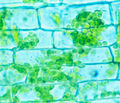Photosynthesis
This article gives an overview of the process called photosynthesis.
Introduction
Photosynthesis is the transformation of light energy into chemical energy for use in living cells. The overall process can be described as:
[math]CO_2 + 2 H_2O \rightarrow (CH_2O)_n + H_2O + O_2[/math]
With the aid of light and plants, water is split into hydrogen and oxygen. Carbohydrates [math](CH2O)[/math] such as sugars and starches are produced.
In plants, photosynthesis occurs in the chloroplasts. These are cell organelles bounded by a double membrane. Within these chloroplasts is a membrane system where light is captured and transformed into chemical energy, through the reaction of carbon dioxide ([math]CO_2[/math]) and water ([math]H_2O[/math]). The membranes are surrounded by spaces where this energy is used to produce the carbohydrates.
Light energy is captured by photosynthetic pigments. All plants have chlorophyll a, which absorbs light energy most efficiently in the blue and green regions of the visible light spectrum.
Other pigments also absorb light, but in the parts of the light spectrum where chlorophyll a is relatively inefficient. These kind of pigments are called accessory pigments.
References
- ↑ http://en.wikipedia.org/wiki/Chloroplast
- ↑ Marshall Sundberg, Emporia State University
Please note that others may also have edited the contents of this article.
|

